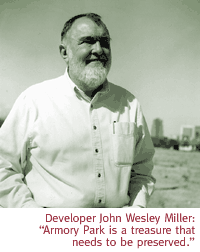
Developer John Wesley Miller Proposes An Ambitious Development For A Downtown Neighborhood.
By Dave Devine
AFTER TWO DECADES of battling proposals for land along
its eastern border, downtown's historic Armory Park neighborhood
may have finally found a project its residents can enthusiastically
support.
When developer John Wesley Miller unveiled his plans to build
99 homes on property at the corner of South Third Avenue and 16th
Street--a 14-acre lot between the neighborhood and the Union Pacific
railroad tracks--he was met with overwhelming approval at a recent
Armory Park Neighborhood Association meeting. Miller told the
30 people in attendance that he wanted to construct single-family
homes, even though the land is zoned for high-density residential
development.
Talk about politically correct development: Miller told the crowd
he'd build homes that were architecturally compatible with the
rest of the neighborhood, and even promised the development would
be the "most significant all-solar project in the country."
To minimize the impact of more cars in the neighborhood, he promised
that parking for the houses would be at the rear of the units
and front doors would look out onto wide pedestrian walkways.
Little wonder that, at the end of his presentation, Armory Park
residents gave Miller a round of applause.
 The neighborhood has rarely been so kind to developers who wanted
to build on the property. In earlier days, the Southern Pacific
Railroad Company maintained executive housing on South Third Avenue,
but by 1967 most of the historic homes had been torn down. The
33-acre site sat vacant until 1979, when the City of Tucson spent
$2.5 million to acquire and clear the land.
The neighborhood has rarely been so kind to developers who wanted
to build on the property. In earlier days, the Southern Pacific
Railroad Company maintained executive housing on South Third Avenue,
but by 1967 most of the historic homes had been torn down. The
33-acre site sat vacant until 1979, when the City of Tucson spent
$2.5 million to acquire and clear the land.
The city adopted a redevelopment plan for the area which called
for the 19 acres along its north and east sides to be zoned for
industrial uses. The remainder of the property was to contain
apartments or other high-density housing with up to 17 units per
acre allowed.
The city sold the land, at a considerable loss, and waited for
someone to develop the property. Instead, a series of bankruptcies
and long delays ensued. Eventually property owner Alan Levine
built industrial buildings on some of the property, but the residential
portion remained bare.
In the meantime, Armory Park underwent a renaissance, as residents
formed one of Tucson's first neighborhood associations and began
renovating their run-down homes. As the neighborhood association
grew in power, it began to influence proposals for the 14 acres
of vacant land zoned for housing. In 1997, when developer Stan
Abrams attempted to build a high-density development on the property,
neighborhood resistance led him to drop the plans.
But when Miller purchased the land for just over $1 million last
year, saying he intended to build single-family homes at a density
of seven units to the acre rather than the 17 permitted, neighborhood
residents were optimistic for a change. Miller says the 99 homes
should be between 800 and 1,400 square feet on lots ranging from
3,000 to 6,000 square feet. Prices will range from $80,000 to
$150,000.
 Some Armory Park residents are still concerned the development
won't be restricted to single-family homes, given the land's high-density
zoning. Miller pledges to impose conditions on the land to limit
the number of homes and says he'll enforce design guidelines.
"Armory Park is a treasure that needs to be preserved,"
he says.
Some Armory Park residents are still concerned the development
won't be restricted to single-family homes, given the land's high-density
zoning. Miller pledges to impose conditions on the land to limit
the number of homes and says he'll enforce design guidelines.
"Armory Park is a treasure that needs to be preserved,"
he says.
The neighborhood association is still concerned about a promised
private park that will buffer the new development from the enormous
industrial buildings along the property's northern edge. Some
nearby residents fear this green space could become a haven for
the homeless.
Residents are also concerned about additional traffic in the
neighborhood. Armory Park Neighborhood Association president Ken
Seasholes, who supports Miller's proposal, says some traffic-mitigation
measures will be needed along Third Avenue because of the new
construction. He hopes Miller will agree to help cover the cost
of installing the traffic circles or speed humps.
Seasholes thinks the perceived threats from the pocket park may
be overstated.
Miller admits the existing warehouses, along with a new one proposed
for the Arizona Department of Economic Security, will affect the
marketability of the lots along the northern edge of his property,
but says that's just a factor which has to be considered in determining
a price for those lots.
Miller also promises an ambitious solar power plan. Rather than
have the homes rely on individual solar devices, Miller will connect
them to Tucson Electric Power's distribution system. The energy
generated from the solar panels located atop of the structures
in the project will be sold directly to TEP. Although ownership
of these panels--homeowners or outside investors--is still up
in the air, Miller hopes every house in the project will cover
the costs of a monthly electrical bill through the energy exchange.
It's a plan that has neighbors optimistic. As one remarked, "Before
this plan, most of us were hoping the land would turn into a dog
run."

|





